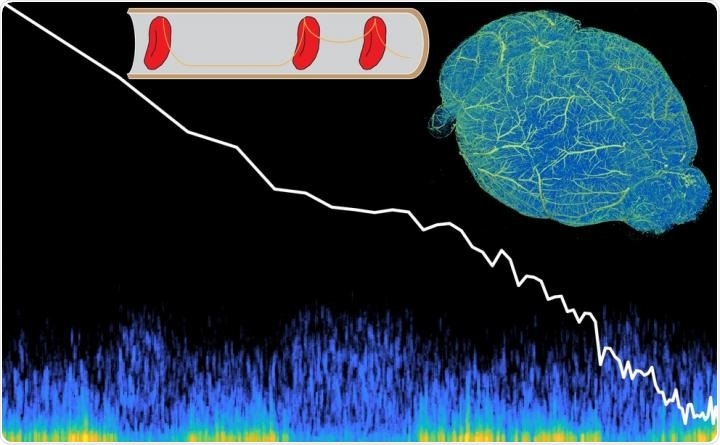The brain is supplied with sufficient nutrients and oxygen due to the blood flow; however, the oxygenation is likely to fluctuate distinctly and uniformly. The cause of this activity is not thoroughly understood yet.

The researchers found that red blood cell “traffic” (top grey bar) appears to contribute to oxygenation fluctuations (white line), which are not correlated to changes in neural activity (bottom blue peaks) in mice brains (top right). Image Credit: Drew Lab and Yongsoo Kim Lab.
Scientists from the Penn State University discovered one of the causes of fluctuation—intrinsic randomness in the flow rate of red blood cells through tiny blood vessels known as capillaries. The scientists explain that this randomness could have possible implications for knowing the biological build-up mechanisms underlying neurodegenerative diseases, like Alzheimer’s disease.
The outcomes of their research have been published in the journal PLOS Biology.
These oxygenation fluctuations also occur in other tissues, like muscle. The question we had was: Are these fluctuations caused by neural activity or something else?”
Patrick Drew, Associate Professor, Engineering Science and Mechanics, Neurosurgery and Biomedical Engineering, Huck Institute of the Life Sciences, Penn State University
The fluctuations mirror 1/f-like noise, a statistical pattern exhibiting large fluctuations constituting several small fluctuations and naturally occurring in different phenomena, from stock-market prices to river heights.
The researchers analyzed the fluctuations in mice caused by the similarities of their brains to those of humans, as stated by Drew, who is also the associate director of the Penn State Neuroscience Institute.
The scientists monitored the blood flow, oxygenation, and electrical signals created by brain activity, and both oxygenation and electrical signals were tracked concurrently in awake mice. The data was gathered when mice moved on a spherical treadmill for up to 40 minutes at a time.
To analyze the relationship between brain activity and oxygenation fluctuations, the team employed pharmacological compounds to temporarily and reversibly mute the neural signals in the brains of the mice. In spite of the silencing, there were continuous fluctuations, exhibiting less correlation between neural activity and oxygenation.
The movement of red blood cells indicated otherwise. The team employed a two-photon laser scanning microscopy, an imaging technique for visualizing cells deep within living tissue, and visualized the passage of individual red blood cells through capillaries.
It’s like traffic. Sometimes there are a lot of cars going by, and the traffic gets plugged up, and sometimes there aren’t. And red blood cells go either way when they approach a junction, so this random flow can lead to bottlenecks and stalls in the vessel.”
Patrick Drew, Associate Professor, Engineering Science and Mechanics, Neurosurgery and Biomedical Engineering, Huck Institute of the Life Sciences, Penn State University
The transfer of experimental data into a statistical model permitted the researchers to run further simulations and make inferences based on enormous amounts of data generated by the model.
The scientists found that these random red blood cell stoppages contributed to the fluctuations in oxygenation, which supports a relationship between the flow of red blood cells through capillaries and the small variations in oxygenation that made larger trends.
According to Drew, a wider understanding of the control of blood flow and ensuing transport of oxygen can help scientists optimize medical technology and explore causes of diseases like Alzheimer’s. Although the scientists determined the link between red blood cell transport and oxygenation, additional investigation is required to examine more contributors to oxygenation fluctuations that could have a role in neurodegenerative diseases.
Source:
Journal reference:
Zhang, Q., et al. (2021) Origins of 1/f-like tissue oxygenation fluctuations in the murine cortex. PLOS Biology. doi.org/10.1371/journal.pbio.3001298.